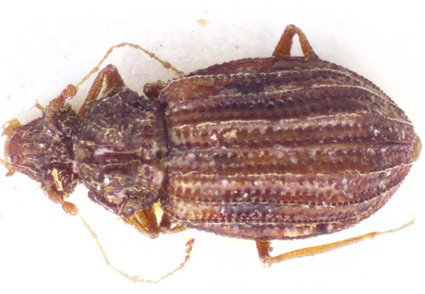Abstract
Dasycerus occultus Hashizume & Maruyama, sp. nov. is described and illustrated based on specimens from Japan (Honshu and Kyushu). The holotype of D. japonicus Nakane, 1963 was revisited. The “D. japonicus” illustrated by Löbl & Calame (1996) was found not to be D. japonicus but rather to be D. occultus sp. nov. The discussion also includes D. poseidon Hu & Liang, 2021 from Taiwan. The phylogenetic relationships of this genus from Japan based on mitochondrial DNA sequences are discussed.
References
Akiyama, Y. (2020) Coleoptera species in Jinseki-gun (19). Hiroshima Mushi-no-Kai Kaiho, 59, 31–33. [in Japanese]
Arai, K. (2009) Newly recorded beetles from Saitama Prefecture (16). Yosegaki, 134, 1–7. [in Japanese]
Cai, C., Thayer, M.K., Newton, A.F., Yin, Z. & Huang, D. (2018) A new genus of dasycerine rove beetles from Upper Cretaceous Burmese amber and its phylogenetic implications (Coleoptera, Staphylinidae). Cretaceous Research, 84, 431–436. https://doi.org/10.1016/j.cretres.2017.12.004
Caterino, M.S. & Langton-Myers, S.S. (2019) Intraspecific diversity and phylogeography in Southern Appalachian Dasycerus carolinensis (Coleoptera: Staphylinidae: Dasycerinae). Insect Systematics and Diversity, 3 (6), 8, 1–12. https://doi.org/10.1093/isd/ixz022
Folmer, O., Black, M., Hoeh, W., Lutz, R. & Vrijenhoek, R. (1994) DNA primers for amplification of mitochondrial cytochrome c oxidase subunit I from diverse metazoan invertebrates. Molecular Marine Biology and Biotechnology, 3 (5), 294–299.
Herman, L.H. (1975) Revision and phylogeny of the monogeneric subfamily Pseudopsinae for the World (Staphylinidae, Coleoptera). Bulletin of the American Museum of Natural History, 155 (3), 242–317.
Hu, F.-S. & Liang, W.-R. (2021) The first record of the subfamily Dasycerinae in Taiwan, with description of a new species (Coleoptera: Staphylinidae). Zootaxa, 4903 (2), 242–254. https://doi.org/10.11646/zootaxa.4903.2.4
Katoh, K. & Standley, D.M. (2013) MAFFT Multiple Sequence Alignment Software Version 7: Improvements in Performance and Usability. Molecular Biology and Evolution, 30 (4), 772–780. https://doi.org/10.1093/molbev/mst010
Kumar, S., Stecher, G., Li, M., Knyaz, C. & Tamura, K. (2018) MEGA X: Molecular evolutionary genetics analysis across computing platforms. Molecular Biology and Evolution, 35, 1547–1549. https://doi.org/10.1093/molbev/msy096
Löbl, I. (1977) Beitrag zur Kenntnis der Gattung Dasycerus Brongniart (Coleoptera, Dasyceridae). Mitteilungen der Schweizerischen Entomologischen Gesellschaft = Bulletin de la Société Entomologique Suisse, 50, 95–106.
Löbl, I. & Calame, F.G. (1996) Taxonomy and phylogeny of the Dasycerinae (Coleoptera: Staphylinidae). Journal of Natural History, 30, 247–291. https://doi.org/10.1080/00222939600771151
Maruyama, M. (2004) A permanent slide pinned under a specimen. Elytra, 32 (2), 276.
Nakane, T. (1963) New or little-known Coleoptera from Japan and its adjacent regions. XVII. Fragmenta Coleopterologica, 5, 21–22.
Saito, A. & Murakawa, I. (2020) Additions and Corrections to “Insect Fauna of the University of Tokyo Chiba Forest” No. 5. Boso no Konchu, 67, 82–83. [in Japanese]
Simon, C., Frati, F., Beckenbach, A., Crespi, B., Liu, H. & Flook, P. (1994) Evolution, weighting, and phylogenetic utility of mitochondrial gene sequences and a compilation of conserved polymerase chain reaction primers. Annals of the Entomological Society of America, 87, 651–701. https://doi.org/10.1093/aesa/87.6.651
Stamatakis, A. (2014) RAxML version 8: a tool for phylogenetic analysis and post-analysis of large phylogenies. Bioinformatics, 30 (9), 1312–1313. https://doi.org/10.1093/bioinformatics/btu033
Tanabe, A.S. (2011) Kakusan4 and Aminosan: two programs for comparing nonpartitioned, proportional, and separate models for combined molecular phylogenetic analyses of multilocus sequence data. Molecular Ecology Resources, 11 (5), 914–921. https://doi.org/10.1111/j.1755-0998.2011.03021.x
Wheeler, Q. (1984) Notes on host association and habitats of Dasyceridae (Coleoptera) in the southern Appalachian Mountains. The Coleopterists Bulletin, 38, 227–231.
Yamamoto, S. (2016) The first fossil of dasycerine rove beetle (Coleoptera: Staphylinidae) from Upper Cretaceous Burmese amber: Phylogenetic implications for the omaliine group subfamilies. Cretaceous Research, 58, 63–68. https://doi.org/10.1016/j.cretres.2015.09.022
Yin, Z.-W., Lü, L., Yamamoto, S., Thayer, M.K., Newton, A.F. & Cai, C.-Y. (2020) Dasycerinae rove beetles: Cretaceous diversification, phylogeny and historical biogeography (Coleoptera: Staphylinidae: Dasycerinae). Cladistics, 37 (2), 185–210. https://doi.org/10.1111/cla.12430


